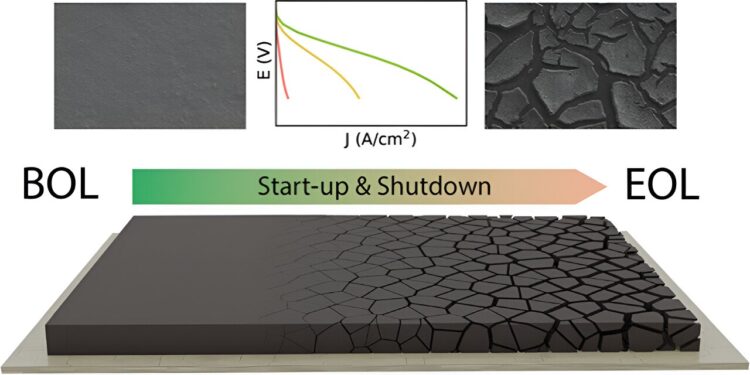Credit: ACS Catalysis (2024). DOI: 10.1021/acscatal.4c00417
Hydrogen is an alternative fuel that is becoming increasingly attractive for heavy-duty vehicles. Hydrogen vehicles emit only water vapour as exhaust gases and, if the hydrogen is produced from renewable energy, it is completely free of carbon dioxide emissions.
Unlike battery electric vehicles, hydrogen vehicles do not need to overload the electricity grid because hydrogen can be produced and stored when electricity is cheap.
For some hydrogen vehicles, propulsion is provided by a fuel cell. However, hydrogen fuel cell vehicles have a relatively short lifespan because fuel cell components, such as electrodes and membranes, degrade over time. This is the problem that a recent study addresses.
Researchers at Chalmers University of Technology have developed a new method to study the factors that influence the aging of fuel cells by tracking a specific particle in the fuel cell during use.
The team of researchers studied an entire fuel cell by disassembling it at regular intervals. Using advanced electron microscopes, they then tracked the degradation of the cathode electrode in specific areas during usage cycles. The latest results are published in the journal ACS Catalysis.
Previous studies have been done on so-called half-cells, which are similar (but not identical) to half of a fuel cell and are done under conditions that differ significantly from the real fuel cell.
Better understanding thanks to a new experimental method
“It was previously thought that performance would be affected by disassembling and studying the fuel cell in the way we did, but it turned out that this assumption is not correct, which is surprising,” says research director Björn Wickman, associate professor in the Department of Physics at Chalmers.
Chalmers researchers were able to study the degradation of the fuel cell material at the nano and micro scale, and determine precisely when and where this degradation occurs. This information provides valuable insights for the development of new, improved fuel cells with a longer lifetime.
“Previously, we were only interested in the ageing of the fuel cell after use. Now we can look at the intermediate phase,” says Linnéa Strandberg, a doctoral student at Chalmers. “Being able to follow a single selected particle in a specific area has given us a better understanding of the degradation processes. Better knowledge of these processes is an important step in designing new materials for fuel cells or in adjusting the control of the fuel cell.”
New method paves the way for more sustainable fuel cells
The U.S. Department of Energy (DOE) has emphasized that improving fuel cell life is one of the most important goals that must be achieved before hydrogen fuel cell vehicles can achieve commercial success. According to the industry, a truck must be able to endure 20,000 to 30,000 hours of driving over its lifetime, something that a hydrogen fuel cell truck cannot do today.
“We have now laid the foundations on which we can build for the development of better fuel cells. We now know more about the processes that take place in the fuel cell and when its lifetime will be. In the future, this method will be used to develop and study new materials that can extend the lifetime of the fuel cell,” says Björn Wickman.
More information:
Linnéa Strandberg et al, Corrosion of carbon support in PEMFCs followed by electron microscopy at identical location, ACS Catalysis (2024). DOI: 10.1021/acscatal.4c00417
Provided by Chalmers University of Technology
Quote:Method paves the way for improved fuel cell vehicles (2024, August 14) retrieved August 14, 2024 from
This document is subject to copyright. Apart from any fair dealing for the purpose of private study or research, no part may be reproduced without written permission. The content is provided for informational purposes only.



